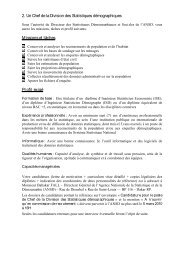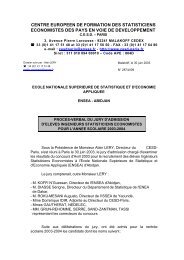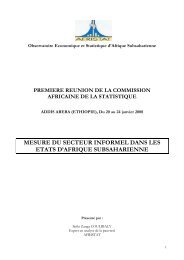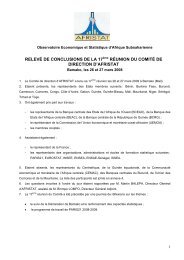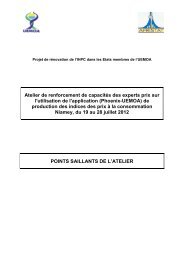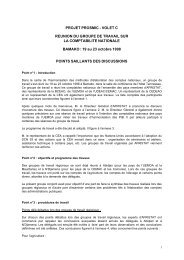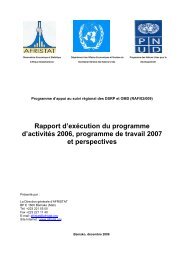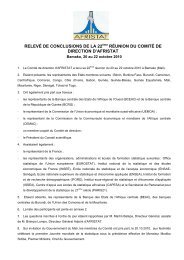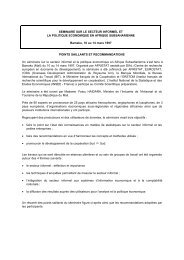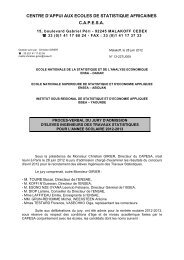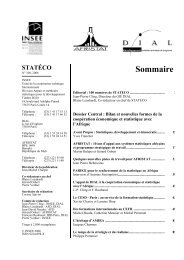Global Purchasing Power Parities and Real Expenditures - Afristat
Global Purchasing Power Parities and Real Expenditures - Afristat
Global Purchasing Power Parities and Real Expenditures - Afristat
Create successful ePaper yourself
Turn your PDF publications into a flip-book with our unique Google optimized e-Paper software.
14 <strong>Global</strong> <strong>Purchasing</strong> <strong>Power</strong> <strong>Parities</strong> <strong>and</strong> <strong>Real</strong> <strong>Expenditures</strong>Figure 3 Per Capita GDP, Actual Individual Consumption,General Government, <strong>and</strong> Gross Fixed Capital Formationby Regions(per capita, PPP-based, world = 100)350300250200150100500Africa Asia-Pacific CIS OECD-Eurostat South America Western Asiagross domestic productcollective consumption expenditure by governmentactual individual consumptiongross fixed capital formationSource: 2005 ICP.The variation across countries is measured by the coefficientof variation; each bar shows the variation from theworld average <strong>and</strong> includes two-thirds of the countries.The per capita expenditures for food <strong>and</strong> nonalcoholicbeverages show the least variation across economies comparedwith the other categories. The chart also shows thatthe basic categories such as food, health, education, <strong>and</strong>housing show the least variability across countries, with thespread increasing for categories reflecting those beyond thebasic necessities. The range in per capita expenditures formiscellaneous goods <strong>and</strong> categories continuing down thechart are more than double that shown for food.Price Level IndexesA price level index (PLI) is the ratio of a PPP to a correspondingexchange rate. PLIs are used to compare pricelevels between economies. They indicate the price of GDP(or its components) in an economy if it were “purchased”after acquiring local currency at the prevailing exchangerate. PLIs are generally low in the poorer economies. Thisreflects the common experience of travelers who find many(but not all) of the goods <strong>and</strong> services in the poorest economiesrelatively cheap compared with similar products intheir home economy. Figure 5 provides a multidimensionalcomparison of the per capita GDP scaled to the size ofthe economy with its price level index. But one can alsosee from figure 5 that for similar per capita GDP levels,PLIs can differ widely across economies. The PLI in Icel<strong>and</strong>is about 60 percent larger than in the United States.Average prices in Fiji are almost three times higher thanin Bolivia. One can also see that after a certain level ofper capita expenditures is reached, there is a rapid rise inprices rather than continued increase in expenditures. ThePLIs also show the relative difference between real expenditures<strong>and</strong> those based on exchange rates. For example,the real GDP is double that of the exchange rate GDP forcountries with a PLI of .50. Similarly, the real GDP forcountries with a PLI greater than 100 is reduced by thesize of the PLI.



